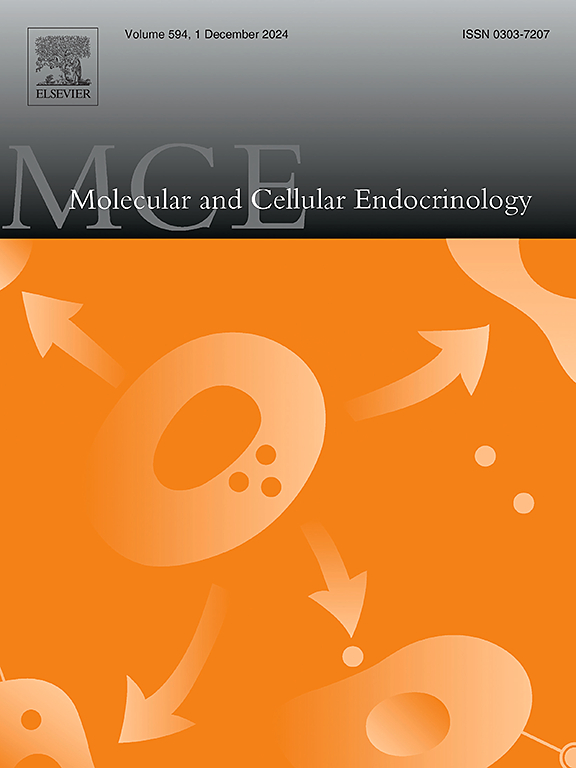Pleiotropic signaling of single-chain thyrostimulin (GPB5-GPA2) on homologous glycoprotein hormone receptors (ScFSHR, ScLHR, ScTSHR) in the elasmobranch Scyliorhinus canicula reproduction
IF 3.6
3区 医学
Q2 CELL BIOLOGY
引用次数: 0
Abstract
The pituitary glycoprotein hormones (GPHs) control several physiological processes in vertebrates such as reproduction and metabolism. They include the luteinizing hormone (LH), the follicle-stimulating hormone (FSH), and the thyroid-stimulating hormone (TSH), which activate their cognate leucine-rich repeat G protein-coupled receptors (LGRs), LHR, FSHR, and TSHR. Each GPH consists of a common α subunit and a specific βFSH, βLH or βTSH subunit. More recently, two supplementary GPH proteins, GPA and GPB, were identified in nearly all bilaterians and are the ancestors of the pituitary GPH α- and β-subunits, respectively. Chondrichthyans (holocephalans and elasmobranchs), the sister group of bony vertebrates, are the most ancient clade to possess diversified GPH subunits. In the present study, GPA2, GPB5, TSHβ2, but not TSHβ1, and TSHR sequences have been identified in several elasmobranch genomes, and their 3D models were analyzed. Functional hormone-receptor interactions were studied in the small-spotted catshark (Scyliorhinus canicula) and showed that conditioned media from cells expressing the recombinant single-chain ScGPB5-ScGPA2 were more effective than independent subunits in activating ScTSHR, ScFSHR, and ScLHR. Expression profiles were analyzed by real-time PCR, in situ hybridization, and immunohistochemistry along the male genital tract, other male and female tissues, and female tissues. A broader tissue distribution expression was observed for tshr and gpa2 than for gpb5, which was mainly observed in the testes. In testis, expression of tshr and gpb5 by Sertoli cells and of gpa2 by germ cells suggested paracrine/autocrine functions of GPA2/GPB5/GPHR signaling during spermatogenesis. This study complements the data on GPA2 and GPB5 by studying a chondrichthyan of phylogenetic interest for understanding the evolution of endocrine regulation in vertebrates.

单链甲状腺素(GPB5-GPA2)对同源糖蛋白激素受体(ScFSHR、ScLHR、ScTSHR)的多效应信号在鞘鳃亚纲鲭鱼繁殖中的作用
垂体糖蛋白激素(GPHs)控制着脊椎动物的生殖和代谢等生理过程。它们包括促黄体生成素(LH)、促卵泡激素(FSH)和促甲状腺激素(TSH),它们激活同源的富含亮氨酸的重复G蛋白偶联受体(lgr)、LHR、FSHR和TSHR。每个GPH由一个共同的α亚基和一个特定的βFSH、βLH或βTSH亚基组成。最近,在几乎所有的双边动物中发现了两种补充的GPH蛋白,GPA和GPB,它们分别是垂体GPH α-和β-亚基的祖先。软骨鱼目(全头目和板鳃目)是骨性脊椎动物的姐妹类群,是拥有多种GPH亚基的最古老的分支。在本研究中,已在若干板鳃目基因组中鉴定出GPA2、GPB5、TSHβ2,但未鉴定出TSHβ1和TSHR序列,并分析了它们的三维模型。在小斑点猫鲨(Scyliorhinus canicula)中研究了功能性激素-受体相互作用,结果表明,来自表达重组单链ScGPB5-ScGPA2的细胞的条件培养基比独立亚基更有效地激活ScTSHR、ScFSHR和ScLHR。通过实时荧光定量PCR、原位杂交和免疫组织化学方法,沿男性生殖道、其他男性和女性组织以及女性组织分析表达谱。与gpb5相比,tshr和gpa2在组织中的表达分布更为广泛,且主要在睾丸中表达。在睾丸中,支持细胞表达tshr和gpb5,生殖细胞表达gpa2,提示在精子发生过程中gpa2 / gpb5 /GPHR信号具有旁分泌/自分泌功能。本研究通过研究一种具有系统发育意义的软骨鱼来补充GPA2和GPB5的数据,以了解脊椎动物内分泌调节的进化。
本文章由计算机程序翻译,如有差异,请以英文原文为准。
求助全文
约1分钟内获得全文
求助全文
来源期刊

Molecular and Cellular Endocrinology
医学-内分泌学与代谢
CiteScore
9.00
自引率
2.40%
发文量
174
审稿时长
42 days
期刊介绍:
Molecular and Cellular Endocrinology was established in 1974 to meet the demand for integrated publication on all aspects related to the genetic and biochemical effects, synthesis and secretions of extracellular signals (hormones, neurotransmitters, etc.) and to the understanding of cellular regulatory mechanisms involved in hormonal control.
 求助内容:
求助内容: 应助结果提醒方式:
应助结果提醒方式:


